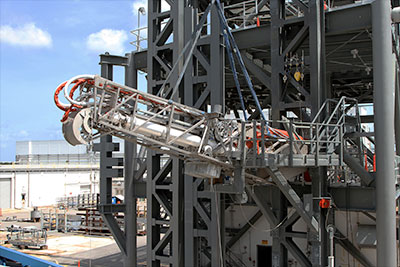Space Launch System Umbilical Testing Underway With Simulated Rocket LaunchWhen NASA’s powerful rocket, the Space Launch System (SLS), is prepared for launch, it will be rolled out to the launch pad aboard a mobile launcher. The launcher will be equipped with a number of lines, called umbilicals, that connect to the rocket and Orion spacecraft to provide power, communications, coolant and fuel. In preparation for the rocket’s first launch on Exploration Mission-1 (EM-1), engineers are conducting a series of tests on the umbilical system, including a simulated rocket launch.

Above: The Orion Service Module Umbilical (OSMU) is lifted into Vehicle Motion Simulator I on June 30 at the Launch Equipment Test Facility at NASA’s Kennedy Space Center in Florida. The OSMU is being prepared for a series of tests that will verify it is functioning properly before it is installed on the mobile launcher. (NASA)
The tower on the mobile launcher contains several of these umbilicals, the first of which to be tested is the Orion service module umbilical (OSMU). This umbilical will be located high on the tower and will transfer liquid coolant for the electronics and air for the Environmental Control System (ECS) prior to launch to the Orion service module that houses critical systems that support the spacecraft.
The Ground Systems Development and Operations (GSDO) Program is coordinating and overseeing the tests at the Launch Equipment Test Facility (LETF) at NASA's Kennedy Space Center in Florida. The LETF will verify the 15-foot umbilical is functioning properly before it is installed on the mobile launcher early next year. During testing, engineers will supply water for the electronics and nitrogen to simulate the ECS.
"This is the second umbilical in a series of tests that we’ll be performing for GSDO," said Martin Grashik, mechanical systems test engineer. "It is the first umbilical for the tower and is more technically complex, and more challenging to test, than anything we’ve done for GSDO so far."
During the first in the series of tests for this umbilical, the OSMU will be attached to a Vehicle Motion Simulator that can simulate all expected launch vehicle motions from rollout through about the first half-second of launch, when the umbilical is disconnected.
The team also will check the OSMU umbilical interfaces for functionality. They will confirm the mechanisms that raise and lower the umbilical are working. Additional tests will evaluate the range of motion on all of the hoses leading from the umbilical and verify the devices that retract the quick-disconnect plates. Engineers also will assess the fire suppression system and adjust the water spray nozzles.
Then, the OSMU will be put through the paces of a simulated rocket launch. Engineers will attach the umbilical to a replicated section of the Orion Service Module on the simulator, and the OSMU will experience the maximum velocity, up to 120 inches per second, during the launch simulation.
"It's a new test for us, simulating the velocity of a rocket launch," said Jeff Crisafulli, NASA LETF manager. "Using two vehicle motion simulators also has significantly reduced testing time, allowing the earliest possible delivery to the mobile launcher for final installation.
This series of tests follows the testing of the first of two aft skirt electrical umbilicals (ASEU). Testing of the OSMU will continue through September when the umbilical will be reconfigured for further testing, and then readied for delivery to the mobile launcher in early 2016. After the OSMU testing, the team will continue testing additional umbilicals that also will be installed on the mobile launcher.
GSDO is performing all of this testing now to ensure that the OSMU and the other umbilicals will be ready for installation on the mobile launcher tower as NASA prepares for the first integrated launch of SLS and Orion on Exploration Mission-1.












